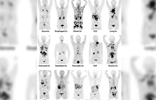Imaging News
Radiotracer identifies 28 kinds of cancer
June 19, 2019
 HEIDELBURG, Germany – A novel class of radiopharmaceuticals has proven effective in non-invasively identifying nearly 30 types of malignant tumors, according to research published in the June issue of The Journal of Nuclear Medicine. Using 68Ga-FAPI positron emission tomography/computed tomography (PET/CT), researchers were able to image a wide variety of tumors with very high uptake and image contrast, paving the way for new applications in tumor characterization, staging and therapy.
HEIDELBURG, Germany – A novel class of radiopharmaceuticals has proven effective in non-invasively identifying nearly 30 types of malignant tumors, according to research published in the June issue of The Journal of Nuclear Medicine. Using 68Ga-FAPI positron emission tomography/computed tomography (PET/CT), researchers were able to image a wide variety of tumors with very high uptake and image contrast, paving the way for new applications in tumor characterization, staging and therapy.
The 68Ga-FAPI radiotracer targets cancer-associated fibroblasts, which can contribute up to 90 percent of a tumor’s mass. Many cancer-associated fibroblasts differ from normal fibroblasts by their specific expression of the fibroblast activation protein, or FAP. FAP-specific inhibitors were first developed as conventional anticancer drugs; now they have been advanced into tumor-targeting radiopharmaceuticals.
In the retrospective study, researchers used PET/CT to image 80 patients with 28 different kinds of cancer, aiming to quantify 68Ga-FAPI uptake in primary, metastatic or recurring cancers. All patients were referred for experimental diagnostics by their treating oncologists because they were facing an unmet diagnostic challenge that could not be solved sufficiently with standard methods. The injected activity for the 68Ga-FAPI examinations was 122-312 MBq, and the PET scans were initiated one hour after injection. Tumor tracer uptake was measured by SUVmean and SUVmax.
All patients tolerated the examination well. As the overall SUV mean, median and range of 68Ga-FAPI in primary tumors and metastatic lesions did not differ significantly, researchers analyzed all results in one group.
The highest average SUVmax (SUVmax >12) was found in sarcoma, esophageal, breast, cholangiocarcinoma and lung cancer. The lowest 68Ga-FAPI uptake (average SUVmax <6) was observed in pheochromocytoma, renal cell, differentiated thyroid, adenoid cystic and gastric cancers. The average SUVmax of hepatocellular, colorectal, head-neck, ovarian, pancreatic and prostate cancer was intermediate (SUVmax 6-12). In addition, the tumor-to-background ratios were more than three-fold in the intermediate group and more than six-fold in the high-intensity uptake group, resulting in high image contrast and excellent tumor delineation.
“The remarkably high uptake of 68Ga-FAPI makes it useful for many cancer types, especially in cases where traditional 18F-FDG PET/CT faces limitations,” said Uwe Haberkorn, MD, professor of nuclear medicine at the University Hospital of Heidelberg and the German Cancer Research Center in Heidelberg, Germany. “For example, low-grade sarcomas generally have a low uptake of 18F-FDG, causing an overlap between benign and malignant lesions. In breast cancer, 18F-FDG PET/CT is commonly used in recurrence, but not generally recommended for initial staging. And for esophageal cancer, 18F-FDG PET/CT often has only a low to moderate sensitivity for lymph node staging.”
In contrast to 18F-FDG PET/CT, 68Ga-FAPI PET/CT can be performed without specific patient preparation such as fasting or recline during uptake time. This is a potential operational advantage for 68Ga-FAPI PET/CT, as it stands to improve patient comfort and accelerate work-flow.
According to Haberkorn, 68Ga-FAPI offers the possibility of a theranostic approach in the future. “Cancer associated fibroblasts have been described as immunosuppressive and as conferring resistance to chemotherapy, which makes them attractive targets for combination therapies,” he said. “Because the 68Ga-FAPI tracers contain the universal DOTA-chelator, it is possible to label them with therapeutic radionuclides whose half-life fits to the tumor retention time of the carrier molecule. Since the tracer has been observed to accumulate in several important tumor entities, there may be a huge field of therapeutic application to be evaluated in the future.”
Reference: Clemens Kratochwil, et al. 68Ga-FAPI PET/CT: Tracer Uptake in 28 Different Kinds of Cancer. J Nucl Med June 1, 2019 vol. 60 no. 6 801-805
